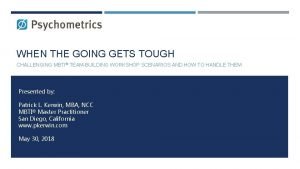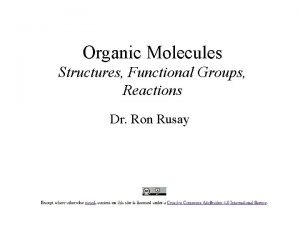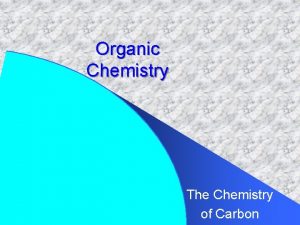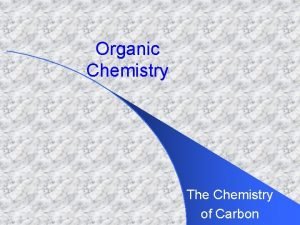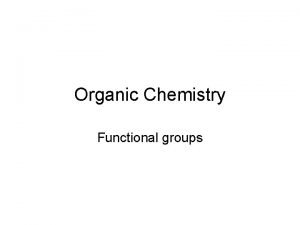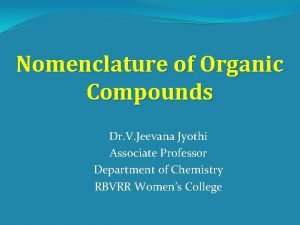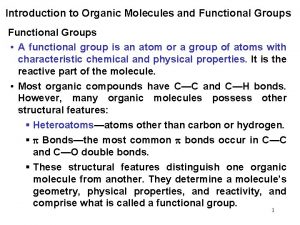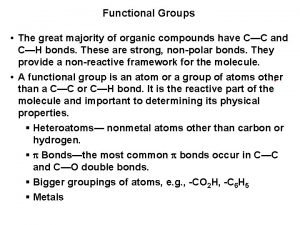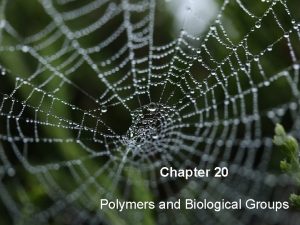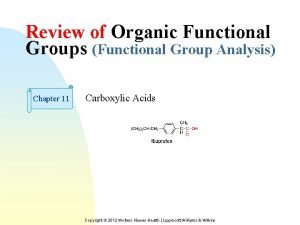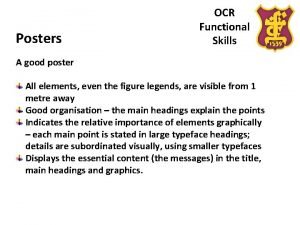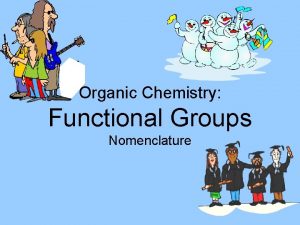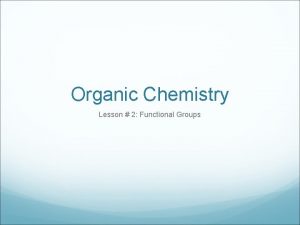Functional Groups A functional group is a small





















- Slides: 21

Functional Groups A functional group is a small group of atoms that lend characteristic properties to the molecule Properties of the molecule are dictated by the functional groups; allows for systematic study of organic molecules


Halides: R-X where R is any alkyl group, and X a halogen CH 3 Cl - chloromethane C 6 H 5 Cl - chlorobenzene Synthesis: radical chain reaction between an alkane and a halogen CH 4 + Cl 2 hn or heat CH 3 Cl + HCl 2 Cl • • Cl + CH 4 HCl + • CH 3 + Cl 2 CH 3 Cl + • Cl

Alcohols: R-OH hydroxyl functional group Nomenclature - use the suffix “ol” CH 3 -CH 2 -OH ethanol CH 3 -CH 2 OH 1 -propanol Primary alcohol Secondary alcohol Tertiary alcohol

Presence of OH group allows hydrogen bonding As the C chain becomes longer the OH group becomes less important Charge distribution in ethanol; red indicates negative charge Synthesis of alcohols Hydrolysis of a alkyl halide with a strong base OH- + CH 3 Br CH 3 OH + Br. Addition across a double bond CH 2=CH 2 + H 2 O 300 - 400 o. C 60 - 70 atm CH 3 CH 2 OH

Phenols: hydroxyl group attached directly to an aromatic ring Phenol (C 6 H 5 OH) weak acid, Ka = 1 x 10 -10; stability of the phenolate ion (C 6 H 5 O-)

Oil of thyme Oil of clove

Ethers: R - O - R C 2 H 5 - O - C 2 H 5 C 6 H 5 - O - C 2 H 5 Synthesis: H SO 2 R-OH 2 4 diethylether ethylphenylether R - O - R + H 2 O Kinetics vs thermodynamics CH 3 -CH 2 -OH + CH 3 -CH 2 -OH H 2 SO 4 140 o. C 180 o. C 2 CH 2=CH 2 + 2 H 2 O CH 3 -CH 2 -O-CH 2 -CH 3 + H 2 O

Aldehydes and Ketones carbonyl group aldehyde ketone HCHO: formaldehyde CH 3 CHO: acetaldehyde CH 3 COCH 3: dimethlyketone (acetone)

Properties of aldehydes and ketones differ because of the aldehyde H atom CH 3 CH 2 OH 1 o alcohol ethanol (CH 3)2 CHOH 2 o alcohol 2 -propanol O 2, catalyst, CH 3 CHO aldehyde acetaldehyde high temperatures O 2, catalyst, high temperatures (CH 3)2 CO dimethylketone

almond and cherries vanilla cinnamon

Carboxylic acids: -COOH functional group HCOOH - formic acid (ant venom) CH 3 COOH - acetic acid (vinegar) Carboxylic acids hydrogen bond - “dimers” Synthesis Catalytic oxidation of aldehydes CH 3 CHO O 2, Mn 2+ CH 3 COOH

Esters: R-COO- R’ acetic acid + ethanol ethylacetate

Fats (solids) and oils (liquids) are triesters formed from glycerol and three carboxylic acids (fatty acids) Tristearin: animal fatty acid tri-esters CH 2 OHCH 2 OH + 3 CH 3(CH 2)16 COOH glycerol stearic acid Saturated - C-C single bonds Unsaturated - one (mono-unsaturated) or more (polyunsaturated) C=C bonds

Amines: ammonia primary amine (1 o) secondary amine (2 o) tertiary amine (3 o)

CH 3 NH 2 (CH 3)2 NH (CH 3)3 N C 6 H 5 NH 2 methylamine dimethylamine trimethylamine aniline Amines are bases: Nic. H 2+(aq) + 2 NH 3(aq) Nic(aq) + 2 NH 4+(aq) Synthesis of amines a) Naturally occurring b) NH 3 + CH 3 Cl CH 3 NH 2 + HCl nicotine

Amino acids: carboxylic acid containing an amine group Glycine: NH 2 COOH

cationic form predominant in acidic solutions dipolar form zwitterion anionic form predominant in basic solutions

Amides: -CONH 2 - group Formed by reaction between NH 3 or 1 o or 2 o amine and acid


glycine + glycine diglycine + H 2 O Proteins: polypeptides with CONH linkage between amino acids http: //www. cryst. bbk. ac. uk/pps 97/course/section 3/helix. pdb
 How are ethnic groups and religious groups related
How are ethnic groups and religious groups related Mbti activities for small groups
Mbti activities for small groups Phylogenetic tree grade 11
Phylogenetic tree grade 11 Making small groups work
Making small groups work Qualitative analysis of organic functional groups
Qualitative analysis of organic functional groups Functional groups in aspirin
Functional groups in aspirin Chiral vs achirla
Chiral vs achirla Coor functional group name
Coor functional group name Order of priority of functional groups
Order of priority of functional groups General formula r3n
General formula r3n Order of priority of functional groups
Order of priority of functional groups Specialization
Specialization Functional group
Functional group Boiling point vs melting point
Boiling point vs melting point Functional groups table
Functional groups table Functional groups
Functional groups Hydrophobic functional groups
Hydrophobic functional groups Ib chemistry functional groups
Ib chemistry functional groups Polypropylene functional groups
Polypropylene functional groups Functional groups of muscles
Functional groups of muscles Functional groups review
Functional groups review Functional skills posters
Functional skills posters

